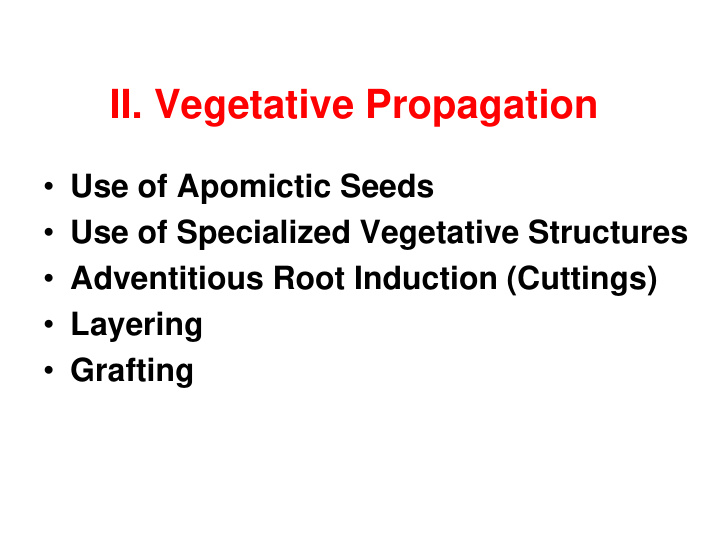



II. Vegetative Propagation • Use of Apomictic Seeds • Use of Specialized Vegetative Structures • Adventitious Root Induction (Cuttings) • Layering • Grafting
a. Use of Apomictic Seeds • Apomixis = Development of seeds from maternal tissue inside ovule • Some apomictic seeds are formed from megaspore mother cells • Apomictic seeds produce plants that are genetically identical as maternal plants • Examples: Mango, Kentucky bluegrass, Citrus
How is Apomictic Seed Formed? Asexual seed formation from maternal tissues around zygotic embryo inside an ovule Apomictic seeds can be formed from nucellar tissues, egg mother cell, flower heads (bulbils) Found in Kentucky bluegrass, dandelion, citrus, Alliums Nucellar embryos in Citrus
b. Specialized Vegetative Structures • Runners (Stolons) • Bulbs • Corms • Rhizomes • Off-Shoots • Stem Tubers • Tuberous Roots • Root Suckers
Runners (Stolons) • Above-ground running stems • New plants are formed on each node • Examples: Strawberry, Spider Plant, Buffalograss Strawberry Buffalograss
Bulbs A specialized underground organ consisting of a basal plate, growing points, flower primordia, and fleshy scales Found in monocots Tunicate bulbs - Onion, tulip, garlic, hyacinth Non-tunicate bulbs – Easter lily, Oriental lily Bulblets, bulbils, stem bulblets
Scaly Bulbs: Easter Lily
Anther Removal on Easter Lily Flowers Pollen germination on stigma triggers ethylene release Yellow color stain makes the flowers unsightly Anthers intact Anthers removed
Corms: Gladiolus
Rhizomes Laterally grown underground stems Iris, ginger, lily of the valley, orchid
Offshoots Lateral shoots, often with roots at the base, produced on main stems which can be separated and grown as independent plants Examples: Pineapple (slip), dendrobium, cymbidium
Stem Tuber Tuber is a swollen, modified stem structure that functions as an underground storage organ Examples: potato, caladium, Jerusalem artichoke Use of eyes in potato propagation
Tuberous Roots
b. Cutting Propagation • Detached stems and roots are used to induce adventitious roots or shoots • Woody Plants • Hardwood cuttings • Softwood cuttings • Semi-hardwood cuttings • Single-node cuttings • Root Cuttings • Problem with phenotype conversion in chimeric plants
Hardwood and Semi-hardwood Cuttings 3 1 2 5 4 6 1 -Stock plant nursery, 2 -making cuttings, 3 -bundles of cuttings, 4 -IBA treatment, 5 -rooting in artificial mix, 6 -outdoor misting system for rooting
Influence of IBA on Rooting- Cordia parvifolia 1 -Control, 2 -50% ethanol, 3 -100 ppm, 4 -1000 ppm, 5 -2000 ppm, 6 -4000 ppm, 7 -6000 ppm, 8 -8000 ppm, 9 -10000 ppm IBA
Cutting Propagation in Jojoba • Regular Stem Cuttings – Use 4-5 nodes – Semi-hardwood cuttings • Single Node Cuttings – Double-eye single node cuttings – Single-eye single node cuttings
Single Node Cuttings of Jojoba Single Node Cuttings SE DE 5-node SE DE
Cutting Propagation in Jojoba
Clonally Propagated Jojoba Field Bakersfield, CA
Shoftwood Cuttings - Hydrangea Use of Butterfly and Single Node Cuttings
Softwood Cuttings-Peach
Herbaceous Cuttings - Carnation
Pauk Ecke’s Poinsettia Greenhouse
Leaf Cuttings-African Violet, Piggyback Plant
Chimeras A plant that is composed of tissues of more than one genotype Chimera (Greek Word) A mythological monster, having a lion’s head, a goat’s body and a serpent’s tail Chimera Periclinal Chimera
Three Types of Chimeras
Examples of Chimeric Plants Chrysanthemum Rose
Propagation by Grafting • Requirements for Success – Compatibility between stock and scion – Alignment of cambium layers – Prompt handling • Grafting Methods – Cleft grafts – Whip-and-Tongue – Side grafts – Budding – Inarching – Bridge Grafts – Topworking
Cleft Graft
Whip Graft, Whip-and-Tongue Graft Whip Graft Whip-and-Tongue Graft
Side Grafts
Budding
Grafted Plants
Bridge Graft and Inarching Rejuvenating old fruit trees Repair damage on the tree trunk Bridge Graft Inarching
Topworking • Scions are grafted on branches of mature trees • Used to change cultivars on old fruit trees
Use of Herbaceous Grafting 1. Virus Indexing 2. Synthetic Plants 3. Construction of Genetic Chimeras 4. Improved Crop Performance 5. Research in Plant Physiology 6. Enhancement of Esthetic Value
Cucurbits (watermelons, melons, cucumbers, squashes, etc.) Various grafting methods in vegetables with or without rootstock root systems Solanaceous crops (tomatoes, peppers, eggplants, paprika, etc.)
Grafted Cactus Production
Position of f gra rafting Tomatoes, gra rafted onto to to tomato ro rootstock (le (left) or r on potato (r (rig ight)
Chinese Cabbage/Radish cabbage/Radish Tomato/eggplant Eggplant/potato
Herbaceous Grafts
Cultivation of Grafted Vegetables in Korea and Japan. J a p a n K o r e a Field+Tunnel Greenhouse Field+Tunnel Greenhouse Crop Total Grafted Total Grafted Total Grafted Total Grafted (ha) (%) (ha) (%) (ha) (%) (ha) (%) Watermelon 14,017 92 3,683 98 13,200 90 21,299 98 Cucumber 10,160 55 5,440 96 1,728 42 5,964 95 Melons 6,142 0 8,258 42 1,047 83 9,365 95 Tomato 6,549 8 7,141 48 258* 0 4,752 15 Eggplant 11,815 43 1,785 94 650* 0 413 10 2,684 – Pepper* 1,468 5 75,574 0 5,085 25
Robotic Grafting Machine
Seedling Grafting on Vegetable Plugs
Herbaceous Grafts
Vascular bundle Cut Diameter of scion: 10 mm. ※ After placing the scion on the top of rootstock to match the vascular bundle, thread or clips are used to hold the position. * Standard rootstock length : 9 cm long * Diameter of rootstock: 30~ 35 mm Hylocereus trigonus , the most popular rootstock for cactus grafting
F G H
Care of grafted watermelon seedlings in a commercial greenhouse
Commercial Cactus Greenhouse in Korea
Recommend
More recommend